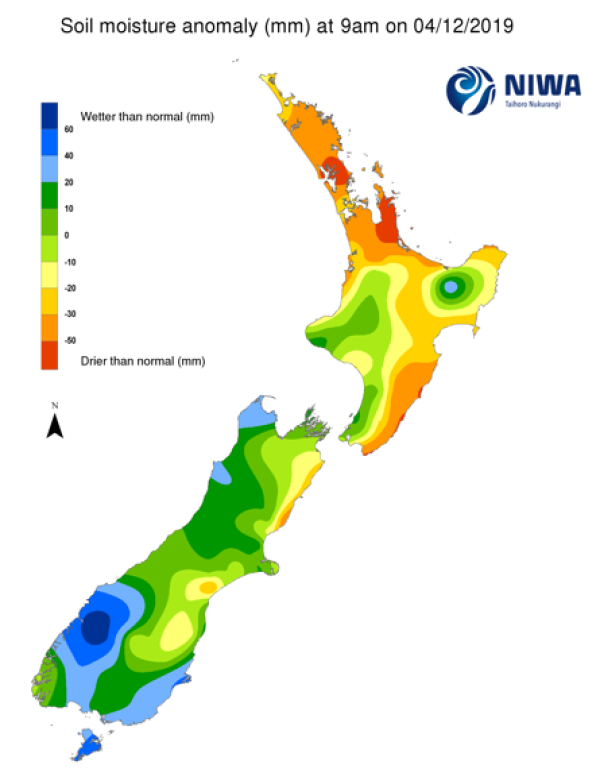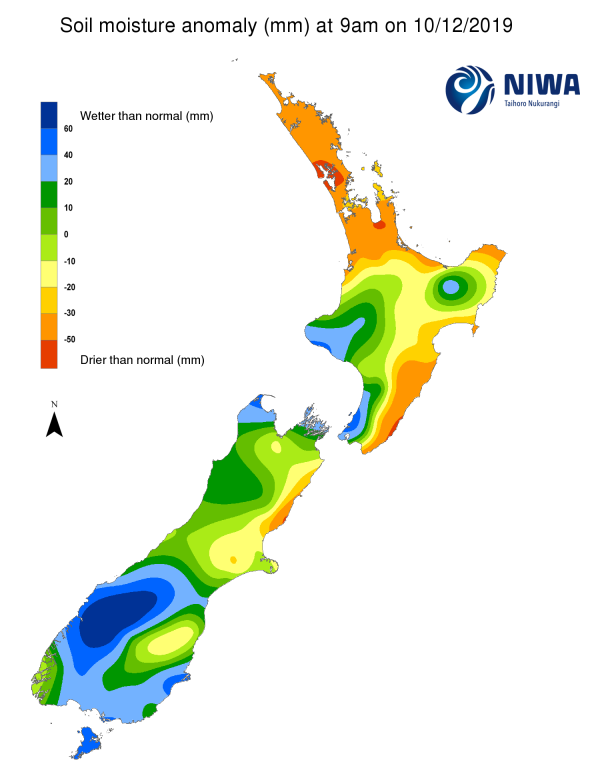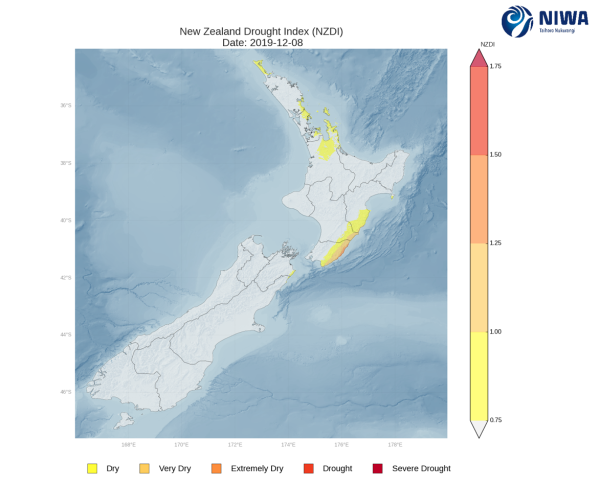A weekly update describing soil moisture across the country to help assess whether severely to extremely dry conditions are occurring or imminent. Regions experiencing these soil moisture deficits are deemed “hotspots”. Persistent hotspot regions have the potential to develop into drought.
Facts: Soil Moisture
Across the North Island, notable increases in soil moisture levels were observed in the southwest, from Taranaki south to Wellington. Smaller increases also occurred in the interior, around the Central Plateau, and in the Coromandel. The majority of upper North Island and coastal Wairarapa continued to observe below to well below soil moisture levels with slight additional decreases in some areas during the past week. The driest soils across the North Island compared to normal for this time of the year are found in southern Northland, northern Auckland, coastal Hauraki District, and coastal Wairarapa. The wettest soils for this time of the year are located in coastal Taranaki and the Kapiti Coast.
Due to decreases in soil moisture levels in the Far North a hotspot emerged in the Aupouri Peninsula during the past week. Additional North Island Hotspots are found in southern Northland, northern Auckland, coastal Hauraki District, and most of the East Coast from Mahia Peninsula south to Wairarapa.
Across the South Island, substantial rainfall during the past week led to soil moisture increases along the lower West coast, Fiordland, parts of Otago, lower Canterbury along with northern Tasman and Marlborough. Conversely, central and upper Canterbury along with southern Marlborough generally observed soil moisture decreases as rainfall during the past week was below normal for the time of year. The driest soils across the South Island compared to normal for this time of the year are found in coastal Hurunui District, while the wettest soils for this time of the year are found in upper Fiordland and the Queenstown-Lakes District.
Due to the rainfall in the past week, the hotspot in coastal Timaru District has dissipated. South Island hotspots are found in the east coast of Marlborough south to the Hurunui District.
Outlook and Soil Moisture
In the North Island, scattered showers and thunderstorms could affect especially central and upper areas on Thursday and Friday (12-13 December). On Monday and Tuesday (16-17 December) an area of low pressure could draw down moisture from the sub-tropics, bringing a chance for widespread rainfall in the North Island. Rainfall totals in northern and central areas along with the Tararuas may exceed 50 mm, with up to 30 mm in the south. Isolated areas in the Gisborne Ranges and in the Central Plateau may see rainfall totals exceeding 75 mm. Rainfall above normal for the time of year is expected in the vast majority of the North Island in the upcoming week, and soil moisture levels are expected to improve. However, less than 20 mm of total rainfall is expected in eastern coastal Wellington and soil moisture levels are therefore expected to observe little or no change in the upcoming week in the Wairarapa.
Almost all current hotspots will likely contract during the upcoming week, while the hotspot in eastern coastal Wellington region may remain largely unchanged.
In the South Island, periods of unsettled weather is expected in the upcoming week. Scattered showers are likely in the south on Thursday (12 December) with more widespread rain possible in western and southern areas on Friday (13 December). On Monday and Tuesday (16-17 December), a frontal passage may bring moderate to heavy rain to the west, north and south with showers in the east. Weekly rainfall totals in the west may exceed 75 mm, with up to 50 mm in eastern Otago and south Canterbury. However, northern and central parts of costal Canterbury may receive less than 20 mm.
Due to the anticipated rainfall, soil moisture levels will likely increase in the west in the next week, while smaller increases will be possible in Southland, Otago, Tasman, Nelson and parts of Marlborough. However, soil moisture levels in northern and central parts of costal Canterbury are expected to slightly decrease or remain unchanged in the upcoming week. This will likely result in slight expansion of the current hotspots in the Hurunui District.
Background:
Hotspot Watch: a weekly advisory service for New Zealand media. It provides soil moisture and precipitation measurements around the country to help assess whether extremely dry conditions are imminent.
Soil moisture deficit: the amount of water needed to bring the soil moisture content back to field capacity, which is the maximum amount of water the soil can hold.
Soil moisture anomaly: the difference between the historical normal soil moisture deficit (or surplus) for a given time of year and actual soil moisture deficits.
Definitions: “Extremely” and “severely” dry soils are based on a combination of the current soil moisture status and the difference from normal soil moisture (see soil moisture maps)
Hotspot: A hotspot is declared if soils are "severely drier than normal" which occurs when Soil Moisture Deficit (SMD) is less than -110 mm AND the Soil Moisture Anomaly is less than -20 mm.
Pictured above: Soil Moisture Anomaly Maps, relative to this time of year. The maps show soil moisture anomaly for the past two weeks.
As of 8 December, the New Zealand Drought Index (NZDI) map below shows that dry to very dry conditions are now located across coastal Wairarapa, with dry conditions also in place in parts of Northland, Auckland and the Coromandel. Please note: some hotspots in the text above may not correspond with the NZDI map, mainly because the NZDI uses additional dryness indices including one which integrates the rainfall deficit over the past 60 days. Changes are therefore slower to appear in the NZDI compared to the instantaneous status maps of soil moisture anomaly.



